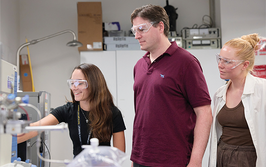Embracing the Proteogenomic Toolkit
To win the war on cancer, we need to put proteomics on an equal footing with genomics.
Andreas Hühmer |
Advances in our understanding of cancer biology through gene expression analysis have resulted in major steps towards the goals of reliable and effective cancer diagnosis, prognosis and treatment. But despite the progress we’ve made over the past few decades, many would justifiably argue that genomics has not fully lived up to its promise.
Although a number of cancer-driving gene mutations have been identified through the genomic characterization of tumor tissue by large-scale projects such as the Cancer Genome Atlas, the widespread identification of targetable cancer drivers remains a significant hurdle. For metastatic breast cancer, for instance, few validated oncogenic drivers exist (1). Moreover, establishing whether gene mutations are cancer “drivers” or “passengers” continues to be a challenge – and is difficult to determine based on genomic assessment alone.
Genomics has taught us that cancer is far more complex than we previously thought. The tumor microenvironment is highly heterogeneous, with significant variability even between individual cancer cells (2). This complexity is compounded by the fact that cancer is dynamic; taking a tumor sample and sequencing its genetic contents merely produces a snapshot, not the blueprints for future tumor growth. The apparent lack of correlation between the genome and phenome highlights the need for a complementary proteomic approach to unravel cancer’s complexity.
Meanwhile, our ability to map out the proteomic landscape within tumor tissue has steadily grown over the past two decades. Advances in mass spectrometry and informatics now allow us to study protein samples on an unprecedented scale. The latest liquid chromatography-mass spectrometry (LC-MS) technologies, coupled with new multiplexed proteomics approaches based on isobaric labeling and advances in data processing, are leading to improvements in the depth and speed of quantitative proteome profiling – all while using ever smaller sample volumes (3).
But it’s when these two approaches are used in combination that we can make the most progress. Proteomics techniques are now being used alongside genomic analysis to help unlock new cancer immunotherapies far more quickly than conventional approaches (4). Traditionally, the search for targetable cancer antigens was a time-consuming and error-prone process, involving DNA sequencing and mutation prediction algorithms, followed by large-scale immunological assays. Using mass spectrometry to profile peptides directly, we can reduce that timeline to a matter of weeks.
Advances in proteomics technologies are also driving improvements in cancer biomarker discovery. Recently, groundbreaking research by the Karolinska Institute in Sweden demonstrated the potential of integrating both protein and genetic markers in a single test for prostate cancer (5). And one goal of the US’ National Cancer Moonshot program’s Blood Profiling Atlas project is to develop a readily accessible database of blood biomarkers that will make it easier for oncologists to diagnose patients using liquid biopsies.
Genomics will continue to play an important role in cancer research. However, it is becoming clear that gene expression analysis alone is unable to sufficiently advance our understanding of cancer biology necessary for truly effective patient stratification and personalized therapy. A decade of technological development has made proteomics research-ready; we must now fully use the whole proteogenomics toolkit to truly make inroads on the fight against cancer.
- M Arnedos et al., “Precision medicine for metastatic breast cancer – limitations and solutions”, Nat Rev Clin Oncol, 12, 693–704 (2015). PMID: 26196250.
- N Navin et al., “Tumour evolution inferred by single-cell sequencing”, Nature, 472, 90–94 (2011). PMID: 21399628.
- GC McAlister et al., “MultiNotch MS3 enables accurate, sensitive, and multiplexed detection of differential expression across cancer cell line proteomes”, Anal Chem, 86, 7150–7158 (2014). PMID: 24927332.
- M Bassani-Sternberg et al., “Direct identification of clinically relevant neoepitopes presented on native human melanoma tissue by mass spectrometry”, Nat Commun, 7, 13404 (2016). PMID: 27869121.
- FH Schröder et al., “Screening and prostate cancer mortality: results of the European Randomised Study of Screening for Prostate Cancer (ERSPC) at 13 years of follow-up”, Lancet, 384, 2027–2035 (2014). PMID: 25108889.
Andreas Hühmer is Director, Proteomics and Metabolomics Marketing, Chromatography and Mass Spectrometry, Thermo Fisher Scientific, USA.

















